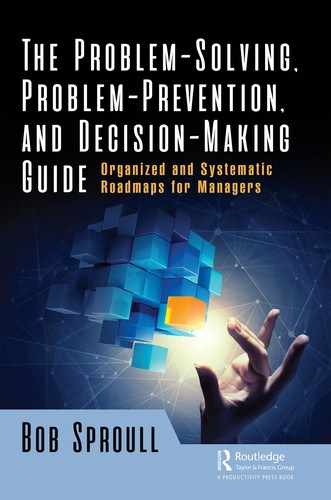Preface
When I was a much, much younger man, just starting my manufacturing career at Xerox Corporation, I remember how one day my new boss called me into his office and told me that he had a problem he wanted me to solve for him. Since it was my first real assignment of substance, I was anxious and wanted to impress him by doing a great job. The only problem was I had no idea how to begin to solve problems and, quite frankly, I was too embarrassed to ask for help. After all, it’s what he hired me to do, so I frantically searched the library (in those days there was no Internet to surf for answers) for a simple reference book on problem solving to guide me, but I couldn’t find one. I couldn’t sleep and I spent days and nights worrying about what to do. I finally did solve the problem, but only after weeks and weeks of simple trial and error, trying different things until I just happened onto the solution. I had no real approach, just simple logic on what I should do next. I realized then that there was a critical need for something to lead or guide people like me through a problem-solving exercise.
It seems that since that day forty-plus years ago not much has changed. I’ve met lots of people working on problems and lots of people complaining about problems, but very few who actually understand how to systematically search for and find the root causes of problems. Just like myself as a young man, many people don’t even know where or how to begin to solve a problem. We humans tend to get bogged down in the minutiae of the unimportant details and fail to realize that solving problems really isn’t that difficult if we simply follow an organized, disciplined, and systematic approach.
I also see many people making bad decisions, jumping to conclusions, or simply treating the symptoms of problems rather than solving them. Every day we are confronted with a plethora of real problems and decisions. Problems that are creating issues like lost throughput, poor quality, personnel problems, and material shortages, and decisions that must be made correctly and efficiently. How we approach these daily quandaries will determine how successful we are at resolving problems and making good decisions. It has been my experience that people like to jump directly into causes and solutions before they even understand the nature of the problem they are trying to solve. Likewise, making good decisions comes only after weeks of effort. As a result, they end up making blind decisions that change perfectly acceptable processes for all the wrong reasons. The danger in this type of approach is that it typically adds numerous non-value-added process steps that complicate, create waste, and destabilize the processes and systems. It is this waste of time, waste of motion, and waste of materials that drive many companies to financial ruin or, worse yet, closure.
The real secret to solving problems does not depend upon the number of sophisticated statistical tools that you know how to use. As a matter of fact, the secret to solving most problems is to keep your approach simple and uncomplicated. Where many people go wrong is that they fail to do what Toyota does so effortlessly. They fail to “go and see.” Solving problems starts by simply going to the problem, observing it, and fully understanding it. As you will see in the chapters that follow, by following a structured approach and using only simple tools, most problems will be solved. And the same can be said for making effective decisions and preventing problems.
The cornerstones of this book are three roadmaps for solving problems, preventing problems, and making decisions. Each roadmap contains a step-by-step explanation on how to solve existing problems, how to prevent future problems, and how to make effective decisions. I also devote much of this book to real case studies for each of the techniques presented.
This book also contains the four basic tools that I have successfully used to solve most problems I have encountered during my career. It is my belief that if you can master the use of these four basic tools, “go and see” the problem, and use my roadmaps to guide you, that you will become much better at solving problems, preventing problems, and making good decisions. I have witnessed many very ordinary people deliver very extraordinary results by simply following the structured roadmaps presented in this book. Solving and preventing problems, and making effective decisions does not have to be full of stress and anxiety if you will simply follow my roadmaps.
Good luck! But remember, my definition of luck is laboring under correct knowledge. That is, you make your own luck!
